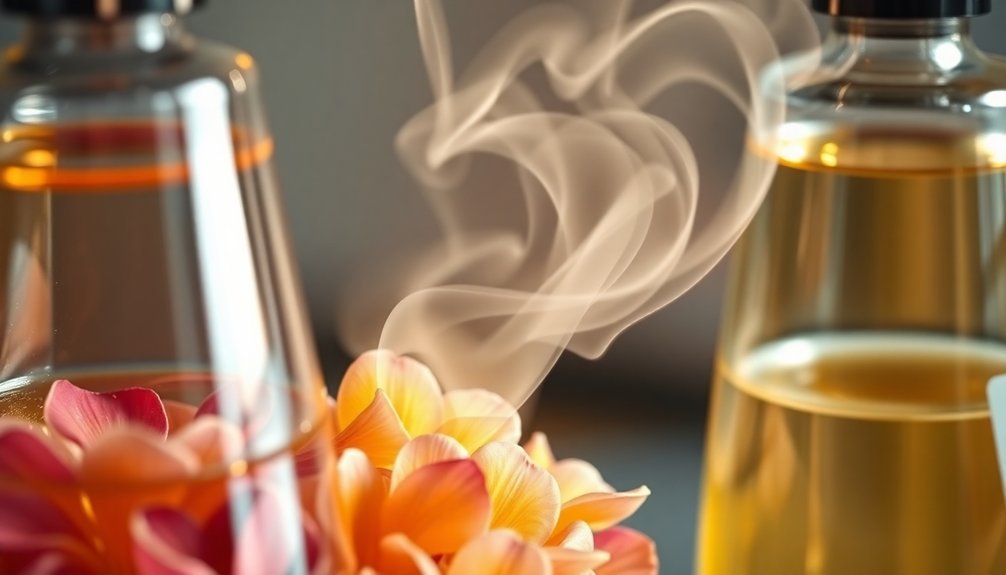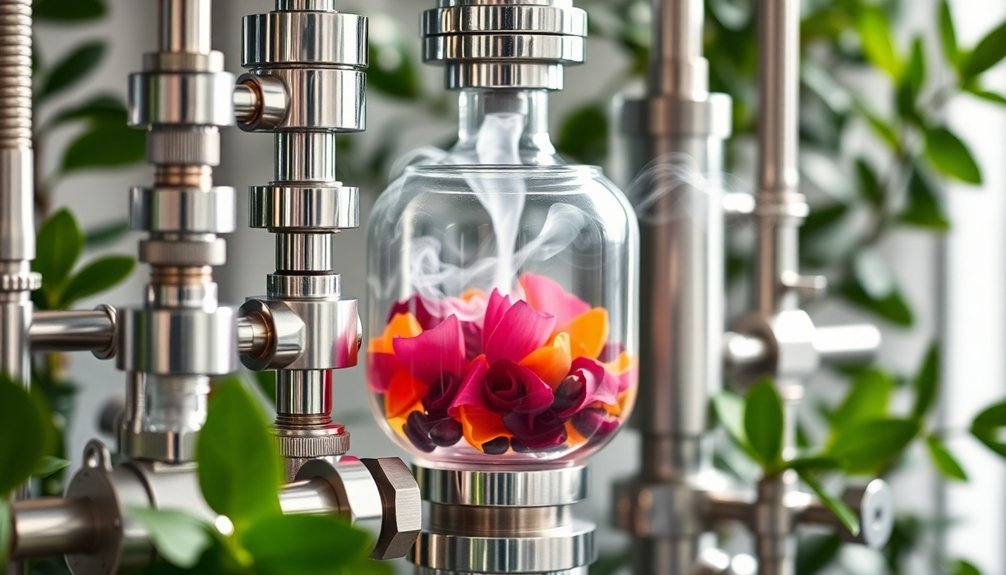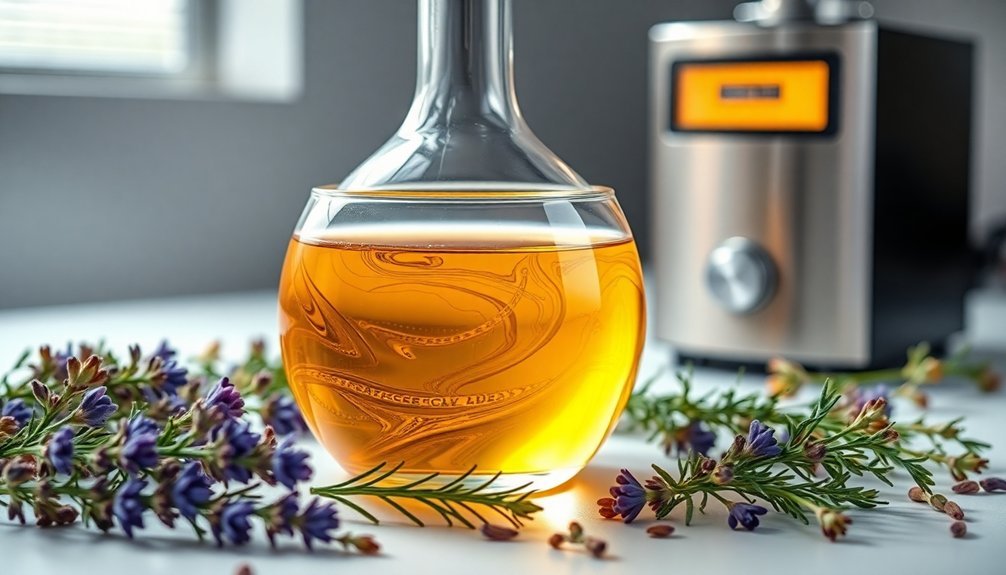The five most effective CO2 extraction methods for natural perfumes include fractional extraction for delicate florals, sequential temperature control for complex aromas, pressure modulation for essential oils, multi-stage botanical layering for precise results, and subcritical processing for light compounds. You'll find these techniques deliver purer, more authentic fragrances than traditional distillation, with each method targeting specific aromatic profiles. Exploring these cutting-edge approaches will transform your understanding of natural perfume creation.
Fractional CO2 Extraction For Delicate Floral Notes

When it comes to capturing the soul of delicate flowers in natural perfumery, fractional CO2 extraction stands out as a revolutionary technique.
This method uses supercritical CO2 in a closed-loop system, where high pressure and temperature create the perfect conditions to extract pure, vibrant essences from botanical materials.
You'll find that this process preserves the most nuanced aspects of a flower's scent by avoiding excessive heat that could damage fragile molecules. The process typically operates at around 80°F to maintain optimal extraction conditions.
As the CO2 passes through the botanicals and is later depressurized, you're left with a highly concentrated extract that's free from solvent residues.
The absence of oxygen during extraction prevents oxidation, ensuring your final product maintains its integrity.
This precision results in oils that are more intense and true to the original flower's aroma, making them ideal for high-end perfumery.
Sequential Temperature-Controlled CO2 Extraction
Through precise temperature control and systematic adjustments, sequential CO2 extraction elevates natural perfume production to new heights of sophistication. You'll be able to target specific aromatic compounds by carefully managing the temperature and pressure conditions in your extraction vessel. This method allows you to capture delicate floral notes while maintaining their natural integrity.
This technique requires no toxic chemicals and ensures the highest level of safety for both producers and end users.
- Extract diverse fragrance compounds at different temperature points
- Preserve the natural complexity of botanical aromas
- Achieve higher purity levels than traditional extraction methods
- Control the extraction process with precise temperature adjustments
- Recycle CO2 for sustainable perfume production
The process starts with loading finely ground plant material into the extraction vessel. As supercritical CO2 flows through, you'll adjust temperatures strategically to dissolve and collect specific aromatic compounds.
The extracted fragrances separate naturally when you reduce the pressure, leaving you with pure, concentrated perfume essences.
Pressure-Modulated CO2 Extraction For Essential Oils

By leveraging precise pressure control, pressure-modulated CO2 extraction offers unparalleled selectivity in essential oil production.
You'll find that operating pressures between 80-350 bar allow you to target specific compounds while leaving unwanted substances behind. This precision means you're getting superior quality aromatics without thermal degradation.
You won't need extensive post-processing steps, as this method bypasses traditional ethanol and activated carbon filtration.
The CO2 solvent is both cost-effective and environmentally friendly since it's recycled throughout the process. You're also reducing your environmental footprint by using a non-flammable, non-toxic solvent that's captured from the atmosphere. The aromatic and therapeutic properties of the oils remain fully intact, unlike with traditional extraction methods.
The method's versatility lets you create pure, market-ready extracts with exceptional therapeutic properties, making it ideal for developing distinctive natural perfumes with controlled composition.
Multi-Stage CO2 Extraction With Botanical Layering
The sophisticated multi-stage CO2 extraction process builds upon standard pressure modulation by incorporating strategic botanical layering.
You'll find that this technique allows for precise control over your natural perfume extractions by placing different botanical materials in filtered cylindrical baskets, each optimized for specific compounds.
- Operates at 19.9-49.9°C with pressures of 8.0-28.0 MPa in a closed-loop system
- Preserves delicate aromatic molecules through lower-temperature processing
- Enables sequential extraction of different botanical layers for targeted compounds
- Collects various extract fractions through specialized separator stages
- Produces solvent-free, pure extracts while maintaining sustainability
The multi-stage approach maximizes both efficiency and quality, letting you extract essential oils, heavier lipids, and other desirable constituents while preserving their natural integrity.
This method's versatility makes it ideal for creating complex, nuanced natural perfumes.
Subcritical CO2 Extraction For Light Aromatic Compounds

When extracting light aromatic compounds for natural perfumes, subcritical CO2 extraction operates at lower pressures and temperatures than its supercritical counterpart. This gentle process targets lightweight aromatic molecules with carbon structures between C5 and C22, making it perfect for capturing delicate volatile compounds that'd be damaged by high heat.
You'll find that subcritical extraction produces fragrances that smell remarkably close to fresh botanical materials. While the yields are lower than supercritical methods, you're getting extracts with more complex aroma profiles and better-preserved therapeutic properties.
You can fine-tune the process by adjusting pressure and temperature to target specific light aromatics soluble in liquefied CO2. The resulting extracts maintain a consistency similar to essential oils while preserving the natural botanical profile of your source material.
Frequently Asked Questions
How Long Does a Typical CO2 Extraction Process Take for Perfume Ingredients?
You'll find the actual CO2 extraction takes just minutes, but you'll need to allow 1-2 hours total when including setup, preparation, and parameter adjustments to get your desired perfume ingredients extracted properly.
What Is the Average Cost Difference Between Co2-Extracted and Traditionally Distilled Perfumes?
You'll typically find CO2-extracted perfumes cost 30-50% more than traditionally distilled ones, due to higher equipment and operational costs, though you're getting superior quality and purer fragrance compounds for your money.
Can CO2 Extraction Be Used With Synthetic Fragrance Materials?
No, you can't use CO2 extraction with synthetic fragrance materials. It's specifically designed for extracting compounds from natural plant materials. Synthetic fragrances are created through chemical synthesis rather than extraction processes.
How Many Times Can CO2 Be Recycled in the Extraction Process?
You can recycle CO2 multiple times in extraction – typically hundreds of cycles – before you'll need to replace it. With proper equipment maintenance and monitoring, you'll only lose small amounts between cycles.
What Percentage of Natural Fragrance Compounds Are Typically Lost During CO2 Extraction?
You'll lose minimal fragrance compounds during CO2 extraction, typically less than 5% of volatile compounds. It's one of the most efficient methods, preserving up to 95-98% of the natural aromatic components.
In Summary
You've now learned five sophisticated CO2 extraction methods that'll transform your natural perfume making. Whether you're working with delicate florals or complex botanical layers, these techniques give you precise control over the aromatic compounds you're targeting. Start experimenting with these methods today, and you'll soon be creating unique, pure fragrances that capture nature's authentic scents with professional-grade results.





Leave a Reply